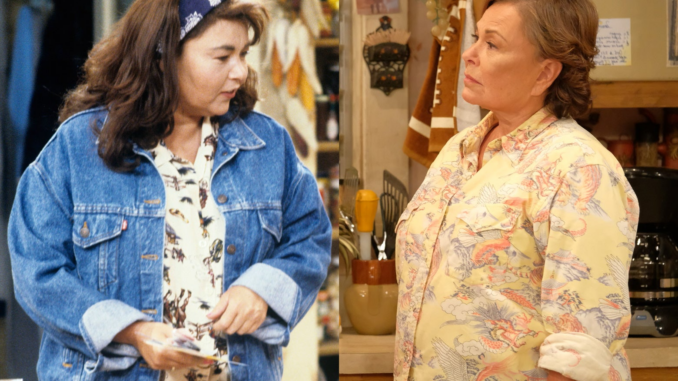
“Roseanne” was never just a typical sitcom. Debuting in 1988, it became one of the most iconic shows of its time by offering a refreshing and honest portrayal of the American working-class family. While most sitcoms in the late ’80s and early ’90s depicted picture-perfect families with minimal struggles, Roseanne broke that mold and captured the challenges faced by real people. Its bold storytelling, complex characters, and unflinching look at social issues made it a standout in television history.
A Real Family in an Unreal World
At the heart of Roseanne is the Conner family, who are far from the cookie-cutter families of other sitcoms like The Cosby Show or Full House. Roseanne Conner, the matriarch, is a sharp-witted, sarcastic woman trying to juggle her family’s financial problems, raising three kids, and keeping her marriage afloat with her husband, Dan. The show takes an unvarnished look at their struggles, including issues like unemployment, economic hardship, and balancing family life with work life. This was something new for audiences who were used to seeing pristine, idealized families on television.
The show also introduced a nuanced depiction of family dynamics, particularly in how it portrayed working-class life. Roseanne and Dan weren’t perfect parents—they made mistakes, argued, and dealt with real problems. But they also loved each other, and their bond was genuine. This authenticity struck a chord with viewers, particularly those in blue-collar households who felt underrepresented on screen. Through the Conners, Roseanne showed that families didn’t need to be perfect to be loved and successful.
Complex Characters and Relatable Relationships
One of the reasons Roseanne remains so beloved is its portrayal of strong, complex characters who felt like real people. The central figure, Roseanne Conner, played by Roseanne Barr, was no typical TV mom. She wasn’t overly sweet, overly tidy, or overly nurturing—traits typically associated with TV mothers. Instead, Roseanne was sarcastic, fiercely independent, and unapologetically herself. Yet, despite her rough edges, she was deeply loving and committed to her family. Her relationship with her husband, Dan (played by John Goodman), was the show’s emotional core. Their partnership was based on mutual respect, humor, and a shared understanding of their struggles. Together, they were a realistic representation of how couples navigate both the highs and lows of life.
Their three children—Becky, Darlene, and DJ—each represented different stages of growing up and the challenges that came with them. Becky, the oldest, often tried to break free from her working-class roots, while Darlene, the more rebellious middle child, mirrored her mother’s sarcasm and sharp wit. DJ, the youngest, was frequently caught in the middle, representing the innocence and confusion of childhood. These characters weren’t mere stereotypes; they were fleshed-out individuals with real problems and dreams.
Even secondary characters like Jackie, Roseanne’s younger sister, and the Conner family’s neighbors contributed to the show’s success. Jackie, who was portrayed as a free spirit, was another figure who defied typical gender expectations for women. The relationship between Roseanne and Jackie was realistic in its ups and downs, and it brought an emotional depth to the series.
Breaking New Ground with Real-Life Issues
While Roseanne excelled at being funny, it was also groundbreaking in how it dealt with tough, real-life issues. Unlike other sitcoms, it didn’t shy away from hard topics like financial instability, addiction, and personal crises. It talked about the challenges of living paycheck to paycheck, raising children in an imperfect world, and dealing with a society that often overlooks blue-collar families.
The show also dealt with controversial topics, including domestic violence, mental health, and LGBTQ+ issues. For instance, when Roseanne’s sister Jackie was in an abusive relationship, the show addressed the cycle of abuse in a way that many viewers had never seen before on a sitcom. The show’s treatment of mental illness—particularly through Roseanne’s own struggles with depression—was also an early example of how television could treat such topics with sensitivity and realism.
Additionally, Roseanne was one of the first shows to feature a lesbian character in a prominent role. Nancy, a friend of the Conner family, came out as a lesbian in a time when LGBTQ+ representation on television was still limited. The show wasn’t afraid to explore these topics in a frank, humorous, and honest way, making it a trailblazer in addressing social issues on network television.
A Cultural Legacy That Endures
Even though Roseanne ended its original run in 1997, the show’s influence on popular culture remains. It paved the way for future sitcoms that took on more realistic portrayals of family life and social issues. Shows like The Middle, Superstore, and This Is Us owe a great deal to Roseanne for demonstrating that TV comedy could be both entertaining and socially conscious.
Despite the show’s eventual controversial revival in 2018—due to Roseanne Barr’s personal actions—the show’s legacy remains strong. The Roseanne revival, while short-lived, proved that audiences were still eager to see the Conner family’s story unfold. Even in its final years, Roseanne continued to speak to the American working class, addressing issues like political divides and the changing nature of family life.
In the end, Roseanne will always be remembered as a groundbreaking sitcom that gave voice to the voiceless and painted a picture of working-class America that felt both realistic and relatable. It remains the ultimate family sitcom because it showed the world that a family could be imperfect and messy, but still full of love.
